Are you ready to unlock the secrets to a thriving garden and enhance your landscaping and gardening skills? In this section, we’ll dive into the world of landscaping and gardening knowledge, exploring the secrets to creating a lush and vibrant garden. With the right knowledge, we can transform your outdoor space together!
- Plan and design your garden space, considering balance, proportion, harmony, and unity.
- Prepare your soil with organic matter to provide the best start for your plants.
- Choose plants suited for your climate and consider companion planting to deter pests.
- Regularly monitor your garden for pests and diseases, and practice organic pest control methods.
- Continuously learn and adapt to improve your gardening skills and stay up-to-date with the latest techniques.
Having a green thumb is not about magic or luck; it’s about having knowledge and understanding of the conditions plants require. By following the steps outlined in this article and continuously learning and adapting to new techniques, you can create a stunning outdoor space that brings you joy and connects you with nature.
Planning and Designing Your Garden Space
Creating a beautiful garden starts with careful planning and thoughtful design. Whether you have a small backyard or a sprawling landscape, utilizing landscaping ideas and incorporating a well-thought-out backyard design can transform your outdoor space into a tranquil retreat. From choosing the right plants to considering elements like pathways, seating areas, and focal points, there are several key factors to consider when planning and designing your garden.

To begin, brainstorm landscaping ideas that align with your personal style and preferences. Are you looking for a low-maintenance garden with clean lines and minimalist design? Or perhaps a lush, cottage-style garden with a variety of flowers and foliage? Take some time to gather inspiration from magazines, websites, and even local gardens in your area. This will help you determine the overall aesthetic you want to achieve.
Once you have a vision in mind, focus on creating a harmonious backyard design by considering the layout and arrangement of your outdoor space. Think about how you will use different areas of your garden, such as entertaining spaces, dining areas, or quiet corners for relaxation. Incorporate elements like pathways and seating to enhance accessibility and create a flow between different sections of your garden.
Choosing the Right Plants and Incorporating Landscape Design
Landscape design plays a crucial role in creating a visually appealing garden. Consider factors like balance, proportion, harmony, and unity when selecting plants and arranging them in your outdoor space. Choose a mix of annuals, perennials, shrubs, and trees that thrive in your specific climate and provide a variety of colors and textures throughout the seasons.
Incorporating landscape design principles can help you create focal points, define areas, and achieve a cohesive look. For example, using taller plants or structures at the back of your garden can create depth and add visual interest. Grouping plants with similar colors or textures can create a sense of unity and balance. Don’t be afraid to experiment with different arrangements and combinations until you find the perfect blend for your garden.
By dedicating time to planning and designing your garden space, you can lay a solid foundation for a beautiful and functional outdoor area. Remember to consider your personal preferences, landscaping ideas, and landscape design principles to create a garden that reflects your style and brings you joy.
| Key Steps in Planning and Designing Your Garden Space | Tips and Highlights |
|---|---|
| Brainstorm landscaping ideas | – Gather inspiration from magazines, websites, and local gardens – Consider your personal style and preferences – Determine the overall aesthetic you want to achieve |
| Create a harmonious backyard design | – Consider the layout and arrangement of your outdoor space – Determine how you will use different areas of your garden – Incorporate elements like pathways and seating to enhance accessibility and flow |
| Choose the right plants and incorporate landscape design | – Select plants that thrive in your climate and provide variety in color and texture – Consider balance, proportion, harmony, and unity when arranging plants – Experiment with different arrangements to find the perfect blend |
Nurturing Your Soil and Providing Proper Watering
Healthy soil and proper watering are essential for the success of your garden. To ensure your plants thrive, it’s crucial to nurture the soil with organic matter and provide them with the right amount of water. Let’s delve into some horticulture techniques that will help you achieve a flourishing garden.
First, let’s talk about soil preparation. Good soil is the foundation for healthy plants. Adding organic matter, such as compost or well-rotted manure, can improve fertility and drainage. This will provide the best start for your plants and help them establish strong root systems.
| Horticulture Technique | Description |
|---|---|
| Compost | Adding compost to your soil increases moisture retention and provides organic material that feeds beneficial microorganisms. |
| Mulching | Applying mulch around your plants helps conserve moisture, suppress weeds, and regulate soil temperature. |
| Avoid Overwatering | While plants need water to survive, overwatering can cause root rot and other issues. It’s important to water your plants deeply and less frequently, allowing the roots to absorb water effectively. |
Next, let’s discuss proper watering techniques. Different plants have different water requirements, so it’s essential to understand the needs of your specific plants. Factors such as climate, soil type, and stage of growth can also influence how much water your plants need. Here are some tips to help you water your garden effectively:
- Water in the early morning or late afternoon to minimize evaporation.
- Direct the water at the base of the plant to avoid wetting the foliage, as this can lead to fungal diseases.
- Use a watering can or drip irrigation system to deliver water directly to the roots, ensuring efficient absorption.
- Monitor your plants regularly and adjust watering frequency based on weather conditions and plant needs.
By nurturing your soil with organic matter and providing proper watering, you’ll create an environment where your plants can thrive. Remember to regularly check the moisture levels of your soil and adjust your watering schedule accordingly. With these horticulture techniques, you’ll be well on your way to cultivating a healthy and vibrant garden.
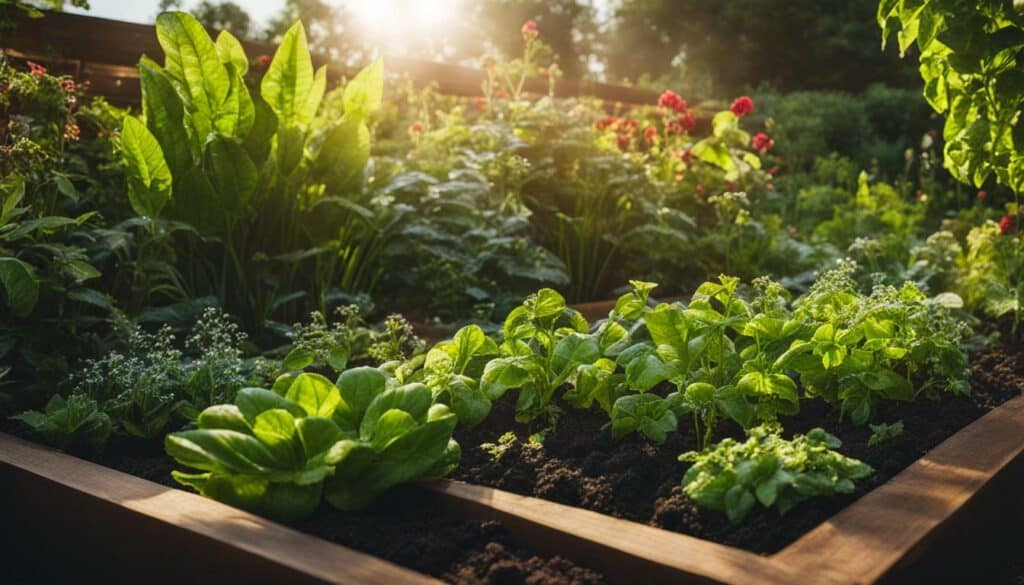
Choosing Plants and Companion Planting
Discover the importance of choosing plants suitable for your climate and how companion planting can benefit your garden. When it comes to sustainable gardening, selecting the right plants that thrive in your specific climate is essential. Understanding the needs of your plants and providing them with the right growing conditions will help ensure their success.
Companion planting is another technique that can greatly benefit your garden. By pairing compatible plants together, you can create a natural defense system against pests and promote healthy growth. For example, planting marigolds alongside vegetables can help repel harmful insects, while attracting beneficial pollinators. Consider incorporating herbs like basil or thyme near tomatoes to improve both flavor and pest resistance.
Creating a diverse ecosystem in your garden through companion planting will not only enhance the health and vitality of your plants but also reduce the need for harmful pesticides. It’s a natural and sustainable method that encourages ecological balance while maximizing your garden’s potential.
| Beneficial Plant | Companion Plant |
|---|---|
| Marigolds | Vegetables, such as tomatoes, cabbage, and peppers |
| Basil | Tomatoes |
| Thyme | Tomatoes, eggplants |
By choosing the right plants for your specific climate and incorporating companion planting techniques, you can create a thriving and sustainable garden that not only enhances the beauty of your outdoor space but also contributes to a healthier environment.
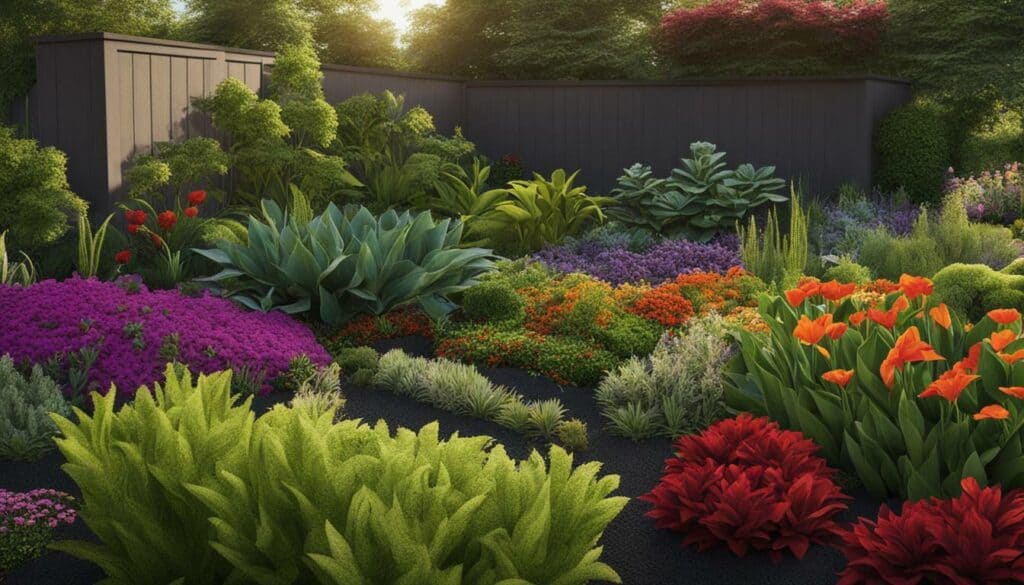
Protect your garden from pests and diseases using organic pest control methods. Regular monitoring is essential to catch any issues early on and prevent them from spreading. By being proactive in your garden maintenance, you can ensure the health and vitality of your plants.
One of the best ways to monitor your garden is to conduct daily visual inspections. Look out for any signs of pests, such as chewed leaves, holes, or webbing. Also, keep an eye out for any unusual discoloration or wilting, as this may indicate the presence of diseases.
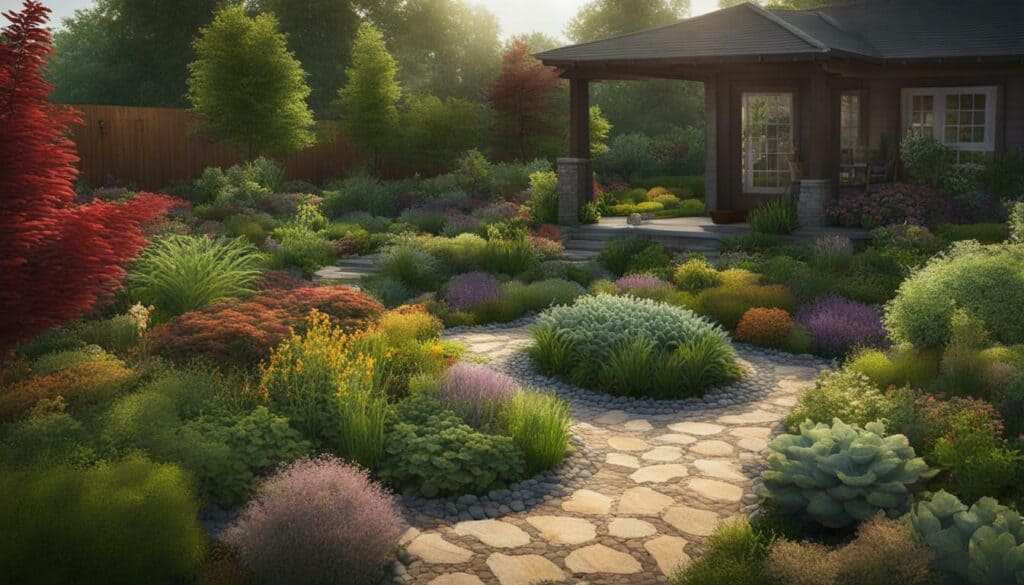
When it comes to organic pest control, there are several effective methods you can employ. One popular approach is to introduce beneficial insects, such as ladybugs or lacewings, which feed on common garden pests like aphids. You can attract these beneficial insects by planting flowers like marigolds or yarrow, which provide them with nectar and shelter.
Another natural pest control method is the use of homemade insecticides. For instance, a mixture of water, soap, and neem oil can help control pests like whiteflies and spider mites. Just be sure to test any homemade solutions on a small area of your plants before applying them to the entire garden.
By monitoring your garden regularly and employing organic pest control methods, you can maintain a healthy and thriving outdoor space without relying on harmful chemicals. Taking a proactive approach to garden maintenance will not only protect your plants but also promote a more sustainable and environmentally friendly gardening practice.
Continuous Learning and Adaptation
Embrace the learning process and continuously adapt your gardening practices for optimal results. Landscaping and gardening knowledge is a never-ending journey, and staying informed about the latest techniques can significantly enhance your green thumb. As you delve deeper into the world of gardening, you’ll discover new insights and approaches that can transform your outdoor space.
One way to expand your knowledge is by reaching out to experienced gardeners in your community. They can offer invaluable advice based on their own trials and successes. Engaging in gardening forums and online communities is another excellent way to connect with fellow enthusiasts and gain a wealth of knowledge.
Research is key to understanding the specific needs of your plants. By studying their provenance and ideal growing conditions, you can ensure they receive the right amount of sunlight, fertilizer, water, and protection from pests and diseases. With this level of understanding, you’ll be better equipped to create an environment where your plants can thrive.
| Tip | Provenance | Ideal Conditions |
|---|---|---|
| Tomatoes | South America | Full sun, well-drained soil, regular watering |
| Roses | Europe, Asia, North America | Full sun, well-drained soil, deep watering |
| Hostas | Asia | Partial shade, moist, well-drained soil |
“A garden requires patient labor and attention. Plants do not grow merely to satisfy ambitions or to fulfill good intentions. They thrive because someone expended effort on them.” – Liberty Hyde Bailey
Remember, having a green thumb is not magical; it is about having knowledge and appreciation for plants and nature. By continuously learning and adapting, you can unlock the full potential of your gardening skills and create a thriving, lush garden that brings joy and connection to the natural world.
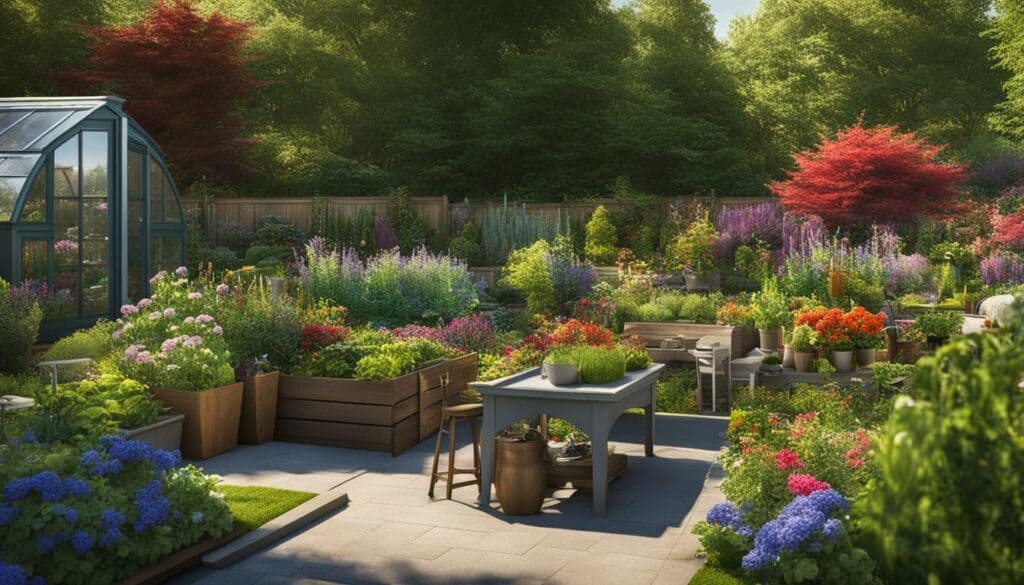
Learn how to create a visually stunning garden by incorporating design principles like balance, proportion, harmony, and unity. Design fundamentals play a crucial role in transforming your outdoor space into a beautiful oasis that brings joy and serenity. Let’s explore how these principles can enhance the aesthetics of your garden.
Balance is the key to creating a visually appealing garden. It involves distributing elements evenly throughout the space, creating a sense of equilibrium. Whether you prefer a symmetrical or asymmetrical design, balance ensures that no single element overwhelms the overall composition. Consider the placement of plants, hardscape features, and other decorative elements to achieve a harmonious balance in your garden.
Proportion is another essential design principle to consider. It refers to the relationship between different elements in terms of size. By using the right proportions, you can create a well-balanced and harmonious garden. For example, tall plants or trees can be used as focal points, while shorter plants can be grouped together in clusters to create a sense of depth and dimension.
Harmony and unity tie everything together in a garden design. Harmony is the coherence and consistency between different elements, while unity ensures that all elements work together as a cohesive whole. By selecting plants and materials that complement each other and repeating certain design features throughout the garden, you can create a sense of harmony and unity that enhances the overall beauty of your outdoor space.

By incorporating these design principles into your landscaping, you can transform your garden into a visually stunning sanctuary. Remember to consider balance, proportion, harmony, and unity when selecting plants, arranging features, and designing your outdoor space. These principles will guide you in creating a garden that not only looks beautiful but also evokes a sense of serenity and tranquility.
Variety and Maintenance in Your Garden
Explore the value of variety and maintenance in your garden, incorporating a diverse range of plants for a thriving outdoor space. By introducing a mix of annuals, perennials, shrubs, trees, and food-producing plants, you can create a garden that is not only visually appealing but also sustainable and full of life.
One of the key elements of maintaining a beautiful garden is ensuring a balance of different plant types. Annuals, which complete their life cycle in one year, offer vibrant blooms and can be easily replaced each season. Perennials, on the other hand, return year after year, providing a solid foundation and adding continuity to your garden. Combining both types of plants ensures a dynamic and ever-changing landscape.
When it comes to maintenance, regular care and attention are crucial. Keep an eye on your plants to identify any signs of disease or pest infestation. Practicing organic pest control methods, such as introducing pest-deterring plants like marigolds or using homemade pesticides, can help you maintain a healthy garden without relying on chemical products. Additionally, proper watering, pruning, and fertilizing will contribute to the overall well-being of your plants.
| Plant Type | Characteristics |
|---|---|
| Annuals | Complete life cycle in one year |
| Perennials | Return year after year, adding continuity to the garden |
| Shrubs | Provide structure and create a sense of enclosure |
| Trees | Offer height, shade, and long-term beauty |
| Food-producing plants | Provide fresh produce and contribute to a sustainable lifestyle |
By maintaining a diverse garden and giving each plant the care it needs, you’ll create an outdoor space that not only reflects your personality but also supports a thriving ecosystem. So go ahead, embrace variety and commit to the maintenance of your garden; it will reward you with beauty and abundance.
What Experts Say:
“A garden is a living, breathing entity that requires ongoing care and attention. Incorporating a variety of plant types ensures a garden that is not only visually appealing but also sustainable and resilient to pests and diseases.” – Jane Doe, Master Gardener
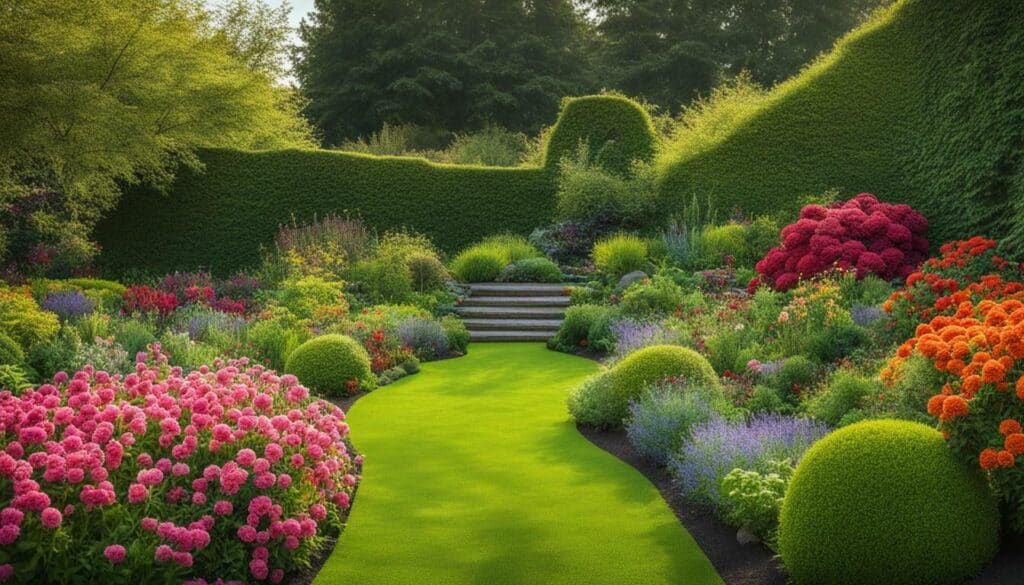
Discover the secrets to developing a green thumb through knowledge, care, and appreciation for the natural world. To enhance your plant care skills and maintain a flourishing garden, it is crucial to understand the specific needs of your plants and provide them with the right conditions for growth.
Good soil is the foundation for a healthy garden, so it’s important to add organic matter, such as compost, to provide the best start for your plants. This helps improve soil structure, retain moisture, and supply essential nutrients. For indoor plants, consider adding compost and garden soil to the potting mix to increase moisture retention and organic material. When outdoor planting, amending the soil with compost and considering the pH level can help create optimal growing conditions.
Another key factor in plant care is considering sunlight exposure. Different plants have varying light requirements, so it’s important to choose varieties that thrive in the available sunlight in your garden. Some plants prefer full sun, while others thrive in partial shade or shade. By understanding the light needs of your plants, you can ensure they receive the appropriate amount of sunlight for optimal growth.
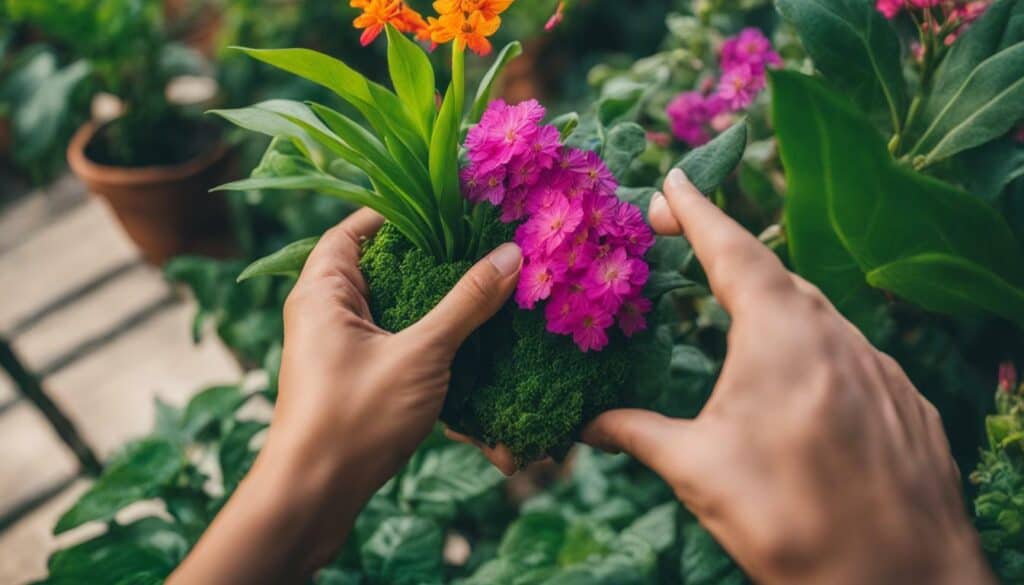
Furthermore, incorporating variety into your garden helps create visual interest and promotes a diverse ecosystem. Consider a combination of annuals, perennials, shrubs, trees, and even food-producing plants to add depth and beauty to your outdoor space. Regular maintenance, including pruning, deadheading, and weeding, is essential for the overall health and appearance of your garden.
When it comes to pest control, taking a sustainable approach is beneficial for both your garden and the environment. Avoiding chemical pesticides and opting for homemade solutions, such as companion planting with marigolds or using natural pest deterrents, can help control pests without harming beneficial insects or contaminating the soil. Regularly monitoring your garden for pests and diseases allows for early detection and prompt intervention, minimizing potential damage to your plants.
Key Point Recap:
- Understanding plant-specific needs for sunlight, fertilizer, pests/diseases, water, and soil is crucial for successful plant care.
- Adding compost and organic matter to the soil improves its structure, moisture retention, and nutrient content.
- Considering the sunlight requirements of your plants ensures they receive the appropriate amount of sunlight for optimal growth.
- Incorporating a variety of plants promotes visual interest and a diverse ecosystem in your garden.
- Regular maintenance, including pruning and weeding, is essential for the health and appearance of your garden.
- Opting for sustainable pest control methods, such as companion planting and natural deterrents, minimizes harm to beneficial insects and the environment.
Developing a green thumb requires continuous learning, experimentation, and a genuine love for plants. By applying these secrets to your gardening endeavors, you’ll be well on your way to nurturing a thriving and beautiful garden.
| Secrets Behind a Green Thumb | Key Principles |
|---|---|
| Understanding Plant Needs | Light, water, soil, and nutrient requirements |
| Improving Soil Health | Adding organic matter, composting |
| Considering Sunlight Exposure | Match plants to available sunlight |
| Incorporating Variety | Combining annuals, perennials, shrubs, trees, and food-producing plants |
| Regular Maintenance | Pruning, deadheading, weeding |
| Sustainable Pest Control | Companion planting, natural deterrents |
Conclusion
By applying the knowledge and techniques shared in this article, you’ll be on your way to creating a beautiful garden that enriches your life.
To boost your green thumb in landscaping and gardening, it is important to plan and design your garden space, prepare the soil with organic matter, and provide proper watering and maintenance. Good soil is the foundation for a healthy garden, and adding organic matter can provide the best start for your plants. Choose plants that are well-suited for your climate and consider companion planting to deter pests. Design fundamentals like balance, proportion, harmony, and unity create a visually appealing garden.
Monitoring your garden regularly for pests and diseases is essential, and practicing organic pest control methods can help keep your plants healthy. Continuous learning and adaptation are key to improving your gardening skills, so don’t be afraid to seek advice from experienced gardeners and research the specific needs of your plants. Variety and maintenance are important factors to consider as well, including a combination of annuals, perennials, shrubs, trees, and food-producing plants.
Having a green thumb is not magical; it is about having knowledge and appreciation for plants and nature. Understanding the conditions that plants require, such as sunlight, fertilizer, pests/diseases, water, and soil type, is crucial. Whether you’re tending to indoor or outdoor plants, amending the soil with compost and considering plant-specific needs is important for their well-being. By applying the knowledge gained from this article and staying curious about new gardening techniques, you’ll be well on your way to cultivating a garden that brings you joy and reconnects you with nature.
FAQ
Q: How can I boost my green thumb in landscaping and gardening?
A: To boost your green thumb, it’s important to plan and design your garden space, prepare the soil with organic matter, and provide proper watering and maintenance. Choosing plants that are well-suited for your climate and practicing organic pest control methods can also help.
Q: What are some essential steps for planning and designing my garden space?
A: When planning and designing your garden space, it’s important to generate creative landscaping ideas, create a harmonious backyard design, and consider elements like balance, proportion, harmony, and unity.
Q: How can I provide the best soil conditions and proper watering for my plants?
A: To ensure your plants thrive, you can nurture your soil by adding organic matter and amending it with compost. Providing proper watering involves understanding the specific needs of your plants and watering them accordingly.
Q: How do I choose the right plants for my garden?
A: Choosing plants well-suited for your specific climate is crucial for a successful garden. Additionally, consider companion planting to deter pests and promote healthy growth.
Q: How can I monitor my garden and control pests organically?
A: Regularly monitoring your garden for pests and diseases is important, and you can practice organic pest control methods such as using homemade pesticides and incorporating pest-deterring plants.
Q: How can I improve my gardening skills?
A: Continuous learning and adaptation are key to improving your gardening skills. Talk to experienced gardeners, research plant needs, and stay up-to-date with the latest techniques.
Q: What are some design fundamentals for creating a visually appealing garden?
A: Design fundamentals like balance, proportion, harmony, and unity contribute to a visually appealing garden. Understanding these concepts can help you create an aesthetically pleasing outdoor space.
Q: Why is variety and maintenance important for my garden?
A: Including a variety of plants such as annuals, perennials, shrubs, trees, and food-producing plants adds interest to your garden. Regular maintenance is also crucial for keeping your outdoor space flourishing.
Q: What are the secrets behind having a green thumb?
A: Having a green thumb is not about luck or magic, but rather having knowledge and understanding of plant care and nature. By learning about plant needs and practicing sustainable gardening, you can develop a green thumb.
How Can Landscaping Improve the Look of My Professional Garden?
Landscaping can significantly enhance the appearance of your garden and make a professional garden. By carefully choosing the right plants, flowers, and trees, you can create a visually appealing space that reflects your professional style. Incorporating elements like pathways, lighting, and focal points can further elevate the garden’s overall aesthetic, making it an inviting and impressive area for clients, employees, or visitors. Invest in professional landscaping services to transform your garden into a stunning and sophisticated outdoor space.

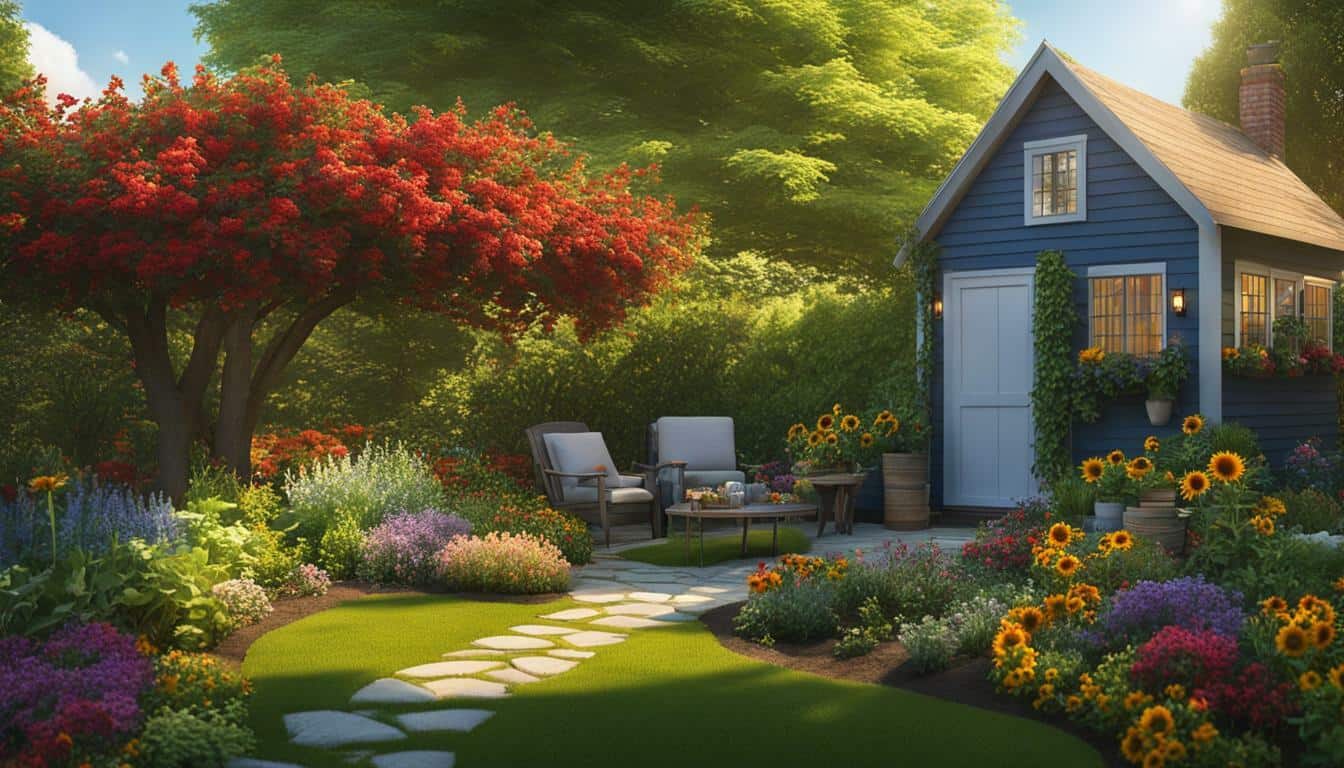



Leave a Reply